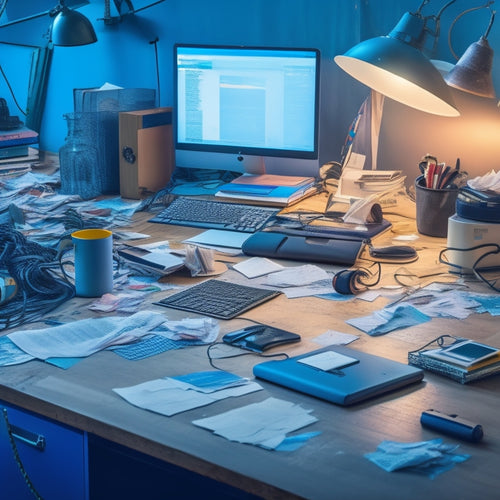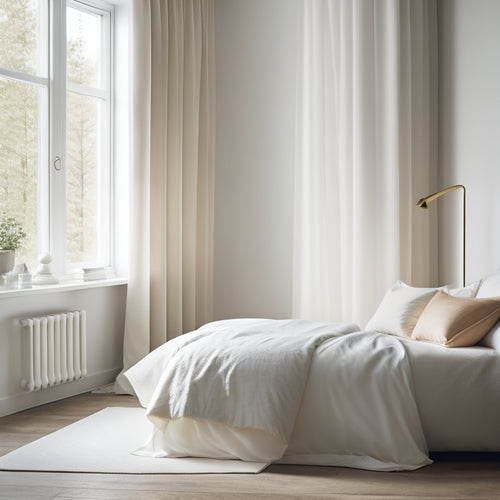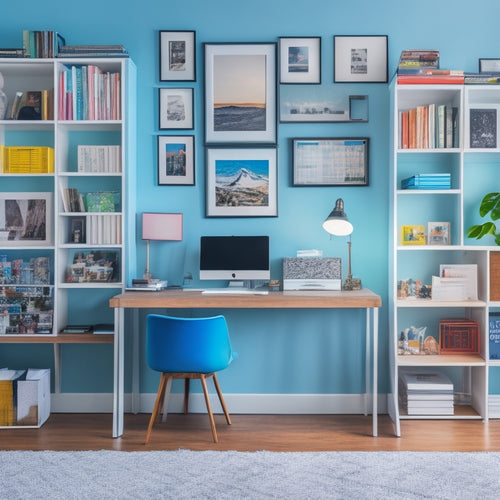
5 Budget-Friendly Hacks for Decluttering Small Spaces
Share
You can declutter your small space without overspending! Start by purging items you haven't used in the past year, and be ruthless with broken or useless things. Repurpose items you're keeping to maximize functionality - get creative and turn trash into treasure! Create vertical storage solutions like wall shelves and ceiling hooks to optimize space without taking up floor room. Identify hidden areas for repurposed storage, and tailor DIY solutions to fit your unique needs. With these budget-friendly hacks, you'll be well on your way to a more organized, peaceful living area - and there's even more where that came from!
Key Takeaways
• Start by purging items not used in the past year, and sort them into keep, donate/sell, and discard piles to free up space.
• Think creatively about repurposing old items to maximize functionality and minimize clutter, adding character to your space.
• Utilize vertical storage solutions like wall shelves and ceiling hooks to optimize storage without taking up floor space.
• Identify and utilize hidden spaces like secret shelves, under-furniture storage, and hollowed-out furniture to store small items.
• Create DIY storage solutions like shelf dividers, decorative crates, and pegboards to fit your unique needs and style on a budget.
Start With a Purge
Purge your small space of anything you haven't used, worn, or looked at in the past year, as the first essential step in decluttering and freeing up valuable space. This decluttering strategy may seem challenging, but it's important to let go of items that no longer serve a purpose. Be honest with yourself - if you haven't touched it in a year, it's likely you won't miss it.
Emotional attachment can make it difficult to part with certain items, but remember that keeping them won't bring back memories or emotions. Instead, it'll only contribute to clutter and disorganization. Take a few minutes to sort items into three piles: keep, donate/sell, and discard. Be ruthless - if it's broken, outdated, or useless, it's time to say goodbye.
As you purge, you'll start to feel a sense of liberation and control over your space. You'll begin to see the potential for a more organized, functional area that reflects your current needs and style.
Repurpose Items You Own
Now that you've purged your space of unnecessary items, it's time to think creatively about the things you've decided to keep, and find new uses for them. This is where repurposing comes in – giving old items alternative uses to maximize their functionality and minimize clutter.
Take a closer look at the items you've kept and think about their potential beyond their original purpose. For instance, an old ladder can become a bookshelf or room divider, while a vintage window can transform into a mirror or decorative wall hanging. This creative reinvention not only breathes new life into old items but also adds character to your space.
Start by identifying the items you want to repurpose and brainstorming potential uses. Then, get creative and make the necessary adjustments to give your items a fresh new look. With a little imagination, you can turn trash into treasure and create a unique, functional space that reflects your personal style.
Create Vertical Storage
Frequently, the most effective way to optimize storage in small spaces is to create vertical storage solutions that maximize your ceiling height. By doing so, you'll be able to store more items without taking up valuable floor space.
One way to achieve this is by installing wall shelves. You can find affordable wall shelves at your local hardware store or online. Install them at different heights to accommodate items of various sizes. For example, you can place larger items like bins or baskets on lower shelves and smaller items like books or decorative pieces on higher shelves.
Another way to create vertical storage is by using ceiling hooks. These are great for hanging items like bikes, pots and pans, or even bags. Ceiling hooks are easy to install and can be found in various styles and materials. You can also use them to hang curtains or dividers to separate areas of your small space.
Utilize Hidden Spaces
You can uncover hidden spaces in your small area by inspecting its architecture and identifying unused or overlooked areas that can be repurposed for storage. Take a closer look at your walls, floors, and ceilings to find potential hiding spots.
For instance, you can install secret shelves behind decorative wall art or sliding panels that conceal hidden compartments. These clever storage solutions will keep your belongings out of sight, freeing up valuable floor space.
Consider the space beneath your bed or couch, which can be used for storing out-of-season clothes, linens, or luggage. You can also utilize the area inside hollowed-out furniture, such as an ottoman or coffee table, to stash small items like books, games, or office supplies.
DIY Storage Solutions
With your hidden spaces maximized, turn your attention to crafting DIY storage solutions that cater to your unique needs and preferences, allowing you to corral clutter and keep your small space organized. By creating your own storage solutions, you can tailor them to fit your specific needs and style. This will help you stay organized and focused, rather than relying on generic storage solutions that may not fit your space.
Here are some DIY storage solutions to get you started:
-
Use shelf dividers to separate items on your shelves and keep them from getting jumbled together.
-
Repurpose decorative crates as storage containers for items like linens, toys, or office supplies.
-
Create a pegboard on a wall or door and hang bins, baskets, and hooks to store items like bags, accessories, and cleaning supplies.
- Upcycle old furniture, like an old ladder or bookshelf, to create a unique storage solution that also adds character to your space.
Frequently Asked Questions
How Do I Stay Motivated During a Long Decluttering Process?
To stay motivated during a long decluttering process, you'll create a reward system, setting small goals and treats, and enlist an accountability partner to check in and provide encouragement, keeping you on track and driven.
What if I'm Attached to Items With Sentimental Value?
You're stuck on sentimental items, but it's time to let go. Create a Memory Box for select keepsakes, and set boundaries to minimize emotional attachment.
Can I Declutter With Kids or Pets Constantly Interrupting?
As you're sorting through clutter, your kid demands snacks and your pet jumps on the pile - sound familiar? Designate kid-friendly zones for simultaneous playtime and schedule pet-free hours to maintain focus and make progress.
How Do I Handle Clutter That's Not Mine, Like a Partner's or Roommate's?
You set boundaries by designating personal spaces and respectfully communicate with your partner or roommate about their clutter, encouraging them to maintain their areas and establishing a mutual understanding of shared spaces.
Is It Worth Hiring a Professional Organizer or Can I Do It Myself?
"Imagine trying to navigate a dense forest without a map - it's like tackling clutter alone. Weigh the cost of DIY mistakes against professional fees; if you're overwhelmed, hiring a pro might be the best investment you'll ever make."
Related Posts
-

What's the Secret to Organizing Digital Clutter?
You're tired of feeling overwhelmed by digital mess, wasting time searching for lost files and drowning in a sea of d...
-

Why Cluttered Bedrooms Are a Thing of the Past
You've finally said goodbye to cluttered bedrooms, thanks to innovative storage solutions that have revolutionized th...
-

Top Digital Tools for Home Organization Success
To achieve home organization success, you'll want to tap into the power of digital tools. Start with decluttering and...


